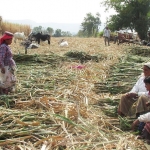Tobacco's Impact on the Environment
A Discussion Paper
"The unheralded scandal of the tobacco industry is the damage to land in developing nations" was the message of a presentation delivered at the Fifth World Conference on Smoking and Health in Canada on July 12, 1983.(1) This discussion paper will adddress, in more detail, the links with tobacco and deforestation, pesticide use, land use, environmental degradation, fires, litter and pollution.
Deforestation is considered one of the most severe environmental problems worldwide. Modern cigarette manufacturing uses wood to cure the tobacco and to roll and package the cigarettes. In fact, a cigarette manufacturing machine uses four miles of paper per hour to roll and package cigarettes. It is estimated that one tree is consumed for every 300 cigarettes produced.(2) In Brazil, the third largest producer and number one exporter of tobacco in the world(3), the country's farmers are estimated to need the wood of 60 million trees a year.4)
This large scale deforestation damages the land and contributes to increased flooding, decreased food output and can affect the local climate. On a global scale, many scientists believe deforestation is changing the world's climate and contributing to global warming.
The industry claims to encourage reforestation programs. But these programs are problematic in that small farmers in the developing world prefer to use their small amount of land to grow food rather than replacement trees. Eucalyptus trees grown for reforestation are used for building while native forests continue to be burned for curing. Small farmers in the developing world cure tobacco on their own land with their own barn, each having to find their own wood. Solar and central curing would save huge amounts of wood, but are not encouraged by the tobacco industry because they would cost the farmer more. Diversifying to grow other cash products isn't always feasible as the economic incentives provided by the tobacco companies make tobacco an irresistibly profitable commodity, especially to poor farmers.
There is also a direct impact on the people living in developing countries. According to Dr. Judith MacKay, director of the Asian Consultancy of Tobacco Control in Hong Kong, the use of peasant farmland for tobacco growth "denies 10-20 million people food...where food has to be imported because the rich farmland is being diverted to tobacco production.."(4) Women in some developing countries carry the heaviest burden since they must carry out farming-related tasks and collect wood for the barns as well as for domestic use. Often times they must travel longer and longer distances to find the wood. When the land no longer sustains them communities may be required to move altogether.
Tobacco growing often exploits of child labor at all stages of cultivation and curing thereby affecting school attendance. Other crops make use of child labor, but tobacco's longer growing season and the curing process seem to place particular strains.(4)
Tobacco cultivation involves a great deal of pesticides which must be used in the all stages of tobacco growth. Because tobacco depletes soil nutrients at a heavy rate, it requires regular inputs of chemical fertilizers. For example, during the three month period from making the seedbed to transplanting the seed in the field, up to 16 applications of pesticide may be recommended (applications depend on climate and local pest problems.(4) Not only do these fertilizers, herbicides and pesticides directly poison farmworkers and may cause chronic health problems, but they also seep into the soil and pollute waterways and ecological systems and poisoning livestock and food crops.(3)
Farmworkers, while harvesting wet tobacco in the fields have been documented as falling ill from a form of nicotine poisoning called "green tobacco sickness" or "green leaf fever". Since 1973, Dr. Stephen Gehlbach of the University of Massachusetts School of Public Health has documented this problem and is quoted on a 1993 "Day One" segment as saying, "its hard to imagine that there is any other occupation where as many people get sick on the job in as short a period of time, where something isn't done about it".(5)
Claims by the tobacco industry that there are no economically viable alternatives to growing tobacco are increasingly being disputed and investigated (especially when the price of tobacco in some developing countries falls dramatically, such as in Malawi in 1993). "There are alternatives to tobacco. Many crops can grow in land that is now under tobacco -- they include the majority of grain crops and vegetables. Sugar cane, bananas, coconut pineapples and cotton could all be suitable."(9)
Finally, in the U.S., cigarette butts account for almost half of the items collected in the annual California statewide cleanup. Nationally, all the cigarette butts thrown away in 1993 weighed as much as 30,800 large elephants.(6) These are washed into rivers, lakes and into the ocean from city streets, through storm drains. Seabirds, animals and fish eat them by mistake. Their bodies have no way to digest the filters and they can die. Cigarette butts take an average of 25 years to decompose.(7)
Cigarettes are the leading cause of fatal household fires, especially endangering children in the United States. In developing countries, fire is an even greater hazard because dwellings are often constructed of highly flammable materials. To date, the tobacco industry has refused to leave out additives to their cigarettes that would keep them burning while unattended, contributing to fatal fires and the most potent type of secondhand smoke.(2) This secondhand smoke is the main source of indoor air pollution and is responsible for the hospitalization of over 115,000 children each year in the U.S. for respiratory infections.(8)
Footnotes
1. Madeley, John, presentation to the 5th World Conference on Smoking and Health, Canada, July 12, 1983.
2. Muller, M, Tobacco in the Third World: Tommorrow's Epidenic?, London: War on Want, 1976.
3. FAO Yearbook, Production, Volume 48, 1995
4. Taylor, Peter, "Smoke Ring: The Politics of Tobacco", Panos Briefing Paper, September 1994, London
5. "Tobacco Field Workers Experience Nicotine Poisoning", Corporate Crime Reporter, 2/14/94.
6. "No Butts About it", Colorado Department of Health and American Cancer Society.
7. Stienstra, Tom, San Francisco Examiner, 9/13/96.
8. Environmental Protection Agency, "Respiratory Health Effects
of Passive Smoke", 12/92 1994
9. Panos Briefing: "Tobacco: The Smoke Blows South",
Panos Briefing Paper, September 1994, London
- 109 Tobacco



